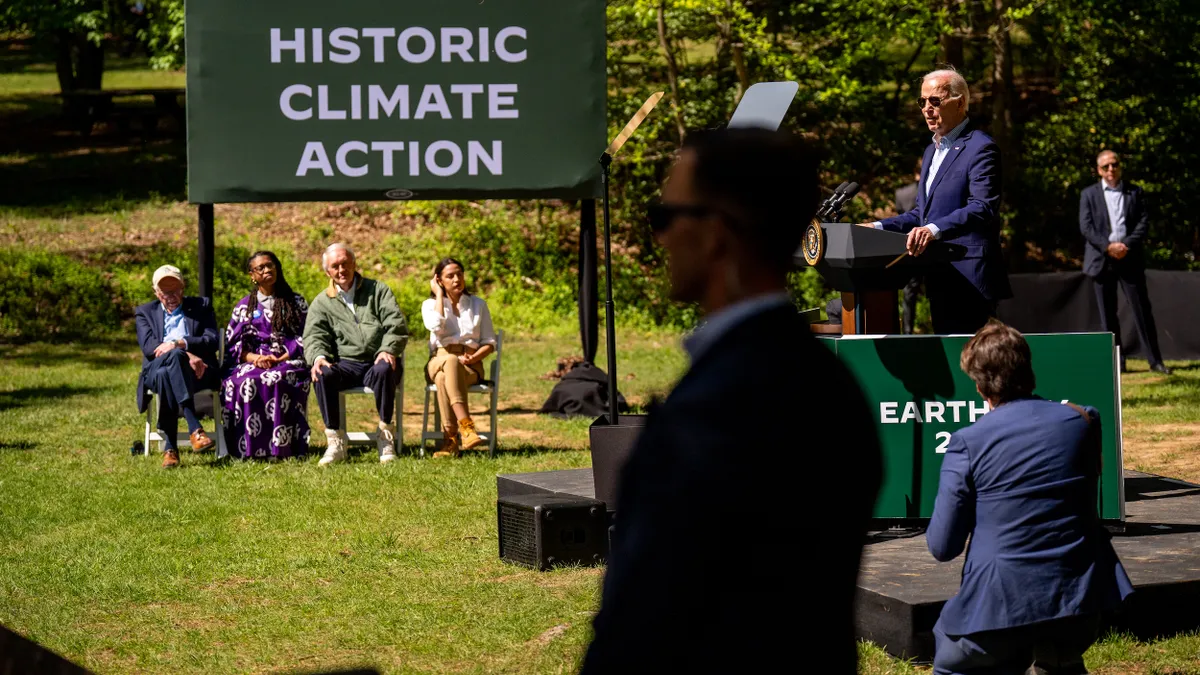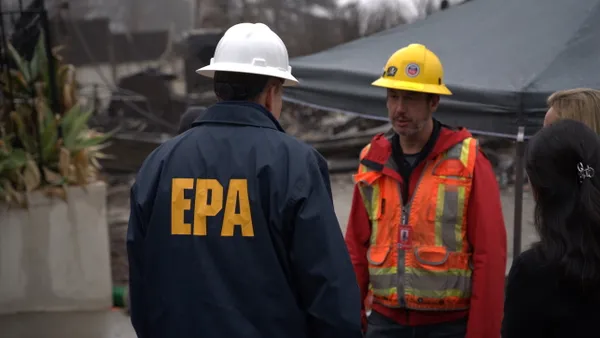Last week's annual Waste Management Sustainability Forum featured multiple updates on new environmental and social initiatives, while also highlighting the industry's increasingly complex role in climate change discussions.
One of the more unique announcements at the two-day virtual event was the nationwide debut of uniforms containing fabric made from recycled plastics. The garments will be available to more than 20,000 drivers, helpers and post-collection employees by the end of the second quarter, according to spokesperson Janette Micelli. Production is underway and employees at legacy Advanced Disposal Services locations will be the first to receive them in the coming weeks. A line of new shirts using the material will also be included for management.
“Our drivers will ride their routes collecting plastic bottles, milk jugs and other materials that will eventually be turned into the uniforms that they wear every day. This is the circular economy in action," said CEO Jim Fish during a video announcement.
The switch is being managed by uniform rental companies Aramark and Cintas. Both will use shirt fabric from Repreve, a Unifi product. In one case, a pair of pants available from Cintas also contains corn-based Sorona fabric that is made by DuPont.
The company's rental costs will be equal or better than prior versions depending on which style employees select. Waste Management noted it "is the first company with Aramark to implement a recycled industrial laundered garment" and the first in the industry to do so with Cintas.
A spokesperson for Unifi described this as a growing trend, citing the use of Repreve fabric in Coca-Cola uniforms supplied by Cintas and Aramark. Other Repreve examples include uniforms for host committee members at the 2019 Super Bowl and used by European workwear companies.
"Waste Management is helping to build momentum for this movement with its commitment to transform plastic bottles into employee uniforms made with Repreve," wrote the spokesperson via email. "We expect more companies to continue to make the switch to sustainably made uniforms."
According to a 2020 Waste Management report, released following a shareholder resolution, an estimated 47% of collected U.S. PET becomes fiber for carpet or clothing while only 21% goes back into food or drink bottles. The report notes that most instances where PET goes back into bottles occurs in states with container deposit systems, a policy the company did not take a position on in that report.
Fabric made from recycled plastics has become more common in uniforms or clothing during recent years. Repreve cites more than 700 brands using its product, derived from more than 24 billion bottles that offset the use of virgin polyester.
More broadly, the fact that Waste Management's announcement is part of a rental model is also seen as beneficial.
"Uniform rental saves ~20% water, 12% energy and 75% soap relative to doing it yourself in terms of home laundry," said Hamzah Mazari, a managing director at Jefferies who covers Aramark and Cintas in addition to the waste industry, via email. He also noted such companies "recycle up to 50% of the wash water in their laundry operations."
ESG showcase
Waste Management's forum, tied to the Phoenix Open golf tournament, is seen as a key opportunity for the company to enhance its environmental, social and corporate governance (ESG) credentials. Previous estimates indicate a multimillion-dollar earned media value, including many opportunities to tout the tournament's "zero waste" status.
Over recent years, each forum generally features news about the company's ESG plans or related work. Prior announcements include the launch of a 2038 greenhouse gas emissions target, donation to marine debris reduction work and the debut of a collection cart using post-consumer recycled content.
This year, Waste Management also mentioned plans to invest another $100 million in recycling collection and processing infrastructure – the fourth year in a row, according to Micelli – along with new partnerships related to 2025 diversity and inclusion targets. Examples of work related to the latter category include partnerships with organizations such as UpSpire and Concordance Academy to expand employment opportunities for "overlooked and underserved" groups.
Analysts and others generally agree one of the event's most notable factors is how it helps Waste Management craft its desired image as a corporate "thought leader."
Prior years have featured John Kerry and other notable names. This year's virtual forum placed Fish alongside CEOs from Walmart and Microsoft for broad discussions on the pandemic, as well as the role of corporations in society. High-profile fashion designer Charles Harbison was also featured in a separate session. Beyond potentially appealing to current or future customers, observers say, it may also help attract future employees as indicated in one session.
“I think that the more purpose-driven companies, companies with a soul, companies with character are going to attract more of the best and brightest," said Indra Nooyi, a former CEO of PepsiCo who is now on Amazon's board of directors. "Without them we won’t be able to be successful, any company."
The landfill factor
In addition to offering the opportunity to position itself as a national name on ESG, the event also presented another opportunity for Waste Management to shape the narrative on its role in the rapidly evolving climate crisis.
Mazari's high-level takeaway was the efforts by waste industry companies to be seen as a solution to this issue will continue gaining greater traction with ESG-driven investors as various factors develop.
"There is likely to be more disclosure around landfill carbon sequestration (landfills get a bad rap but modern day landfills are very different than old landfills that were not highly engineered), greater automation around recycling and potential for new technologies and on the fleet side the potential around electric trucks is in its infancy," wrote Mazari.
According to its latest ESG report, nearly 90% of Waste Management's Scope 1 emissions come from its landfills. The company is the largest landfill operator in North America.
During the forum, as in the past, Senior Director of Sustainability and Policy Susan Robinson said "we think we’re doing a lot better job than the modeling says" and discussed a satellite measurement pilot. The company also emphasized biogas production from its landfills, and the use of compressed natural gas in an estimated 70% of its collection fleet (prior to the Advanced integration), as signs of progress.
Climate discussions occurred across multiple panels, with Waste Management also emphasizing its disaster recovery function.
“We were busy in 2020 responding from storms on one end of the country to fires on the other," said Robinson. "We’ve been adapting to change in our environment caused by climate change, so we really understand how important it is to act now wherever and however we can have an impact."
Speakers from Project Drawdown and other climate groups were on hand to outline the dire consequences of inaction, while also touting signs of optimism that ESG-driven companies were making progress. Tim Juliani, director of U.S. corporate climate engagement at the World Wildlife Fund, said an estimated one-third of companies who set emissions goals approved by the Science Based Targets initiative did so in the last year. Republic Services is the only U.S. waste company with that designation.
Juliani also said to hit a 50% emissions reduction by 2030, the nation will need to be making regular annual progress at levels it has yet to achieve. “The sobering part is how far we’ve come, yet how far and fast we have to go," he said.
Robinson said Waste Management was tracking climate action plans in at least 22 states, with some taking significant action, but also anticipates future federal policy could accelerate this work. The company's MRF infrastructure, compost sites and organics pre-processing facilities were highlighted throughout the event, with at least one video placing the onus for shifting away from disposal in large part on consumers.
“WM is doing its part to make a difference and you can help by buying only what you need, donating unused stuff that can be repurposed, recycling right and using a landfill as a last resort," said the video's narrator.
Disposal remained the company's second-highest source of revenue as of third quarter earnings, after commercial collection, though Waste Management regularly notes recycling performs better from an invested capital standpoint than its landfill business.
While landfill emissions may gain renewed attention under the Biden administration, and landfills remain the most common destination for many materials, the industry's biggest players recently said during a Jefferies investor event they see no sign of the sites losing their primacy. While they called for changes in upstream production and packaging discussions, and anticipated policy changes could be coming around recycling or related areas, executives were not overly concerned that the current system would change at a pace beyond their control.
"[W]e look at trends of waste generation, whether it be with population growth or just trends in consumption, and the waste that we’re all generating each and every day continues to climb in spite of all of the efforts that are undertaken to ensure that we're maximizing the beneficial reuse of any product or good that we use," said Waste Management Chief Financial Officer Devina Rankin during a Jan. 14 session. "So I think from an investor’s perspective there shouldn’t be fear that our landfills will become stranded assets."























